Scary, Spooky, Terrifying Art. Halloween edition
written by Nicholas Skeaping
With Halloween just a few weeks away, we take a look at the selection of the scariest, disturbing and most terrifying art pieces created from the birth of the Gothic art movement up until today. Read more about the artist behind those terrifying pieces, and get some ideas of what to decorate your walls with if you want your guests feel the Halloween spirit even more.
Caspar David Friedrich "Klosterruine im Schnee", after 1819,(Black and white photograph), detail. Image: Pubic Domain
The Origins of Halloween Celebrations and Fascination over Scary Art
Halloween is approaching and that gives an opportunity to look into the origins of the festival and art that is inspired by it or the need to alarm if not frighten the viewer. Originally a Celtic festival of Samhian which goes back over two thousand years it symbolised the boundary between the living and the dead where a Druid lead the celebrations with a fire from which the hearths of the populous were rekindled in order to protect them from evil during the long winter months ahead. Now the festival has been downgraded to children going from door to door dressed seemingly in scary costumes and holding the households to ransom for sweets and the like. Trick or treating trend in America from the 1920’s was certainly pre-dated by Celtic traditions and Christian celebrations on the eve before All Saints Day as well as the Mexican calavertita [a derivative of calavera-skull] where small skull shaped sugar or chocolate delicacies are given out to children. Horace Walpole (1717-1797] with his “The Castle of Otranto” and Mary Shelley [1797-1851], the mother of “Frankenstein” are generally considered the literary revivers of the Gothic style of writing, but what of the artists that could be considered disturbing or ‘scary’?
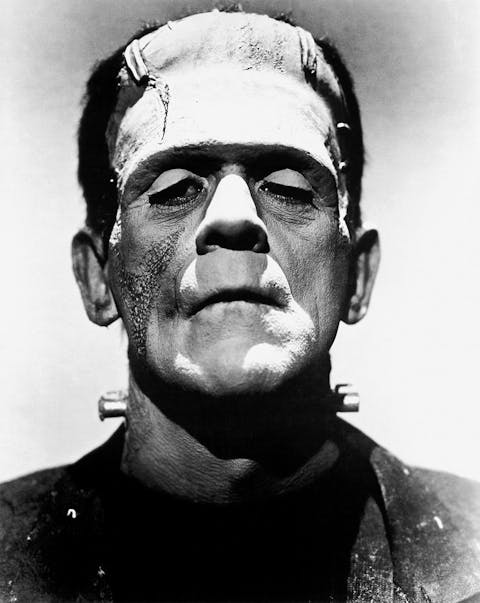
Boris Karloff in Bride of Frankenstein (1935) in a variation of the classic 1931 film version with an assist from make-up artist Jack Pierce. Image: Public Domain
We Are Not Talking Disney Here
We must ignore the Disney interpretations such as witches flying across the moon on broomsticks and look at the more serious. Not all of the artists discussed here were painting Halloween pictures but that the works proved to be disturbing is the main interest. How ‘frightened’ by an image varies with the viewer who may just consider them gruesome or upsetting.
Nightmares, Gnomes and Witches- Henry Fuseli Art
Henry Fuseli the Swiss born but largely UK based painter [1741-1825] must surely be rated as one of the most disturbing image painters of the period. Not specially Halloween in theme does not diminish the impact his work can have. The Nightmare from 1781 now in Detroit with its gnome-like figure sitting on a recumbent maiden would certainly frighten the average child from the doorstep. Other paintings from the Classics and Shakespeare pale in alarm in relation to the painting titled The Night-hag visiting Lapland Witches [the MET] which is hard to describe so disturbing is what is depicted.
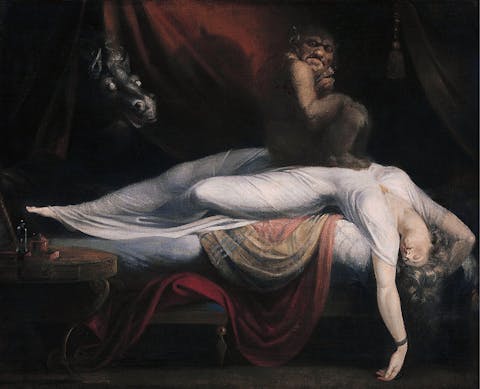
Henry Fuseli, The Nightmare, 1781, Detroit Institute of Arts. Image: Public Domain
"We must ignore the Disney interpretations such as witches flying across the moon on broomsticks and look at the more serious"
Halloween Party at William Blake’s
William Blake [British 1757-1827] was certainly a major player in the world of the disturbing and one of his finest watercolours is his Number of the beast is 666 an 1805 work. A triple headed man-like figure is overlooked by a huge winged man in profile and the artist has managed to incorporate a sheep or sacrificial ‘lamb’ within the image. His Halloween Party at dusk shows figures gathered around a fire with what appears to be pumpkins. Carving them into the shapes of skulls and putting a candle inside was a tradition that started with using turnips so it seems
Related: 10 scariest paintings in Art History
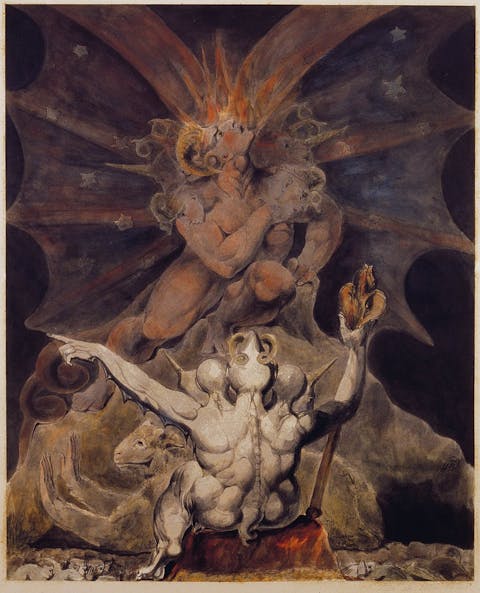
William Blake, The number of the beast is 666, 1805, Philadelphia, Rosenbach Museum and Library. Image: Public Domain
Foggy Landscapes of Caspar David Friedrich
Not all disturbing paintings involve figures and it is possible to be moved emotionally by certain landscapes, many of which involve dusk or at least light that is not ‘blue sky’. Caspar David Friedrich [German 1774-1840] never fails to move the viewer emotionally and for this article I have in mind his Tree of Crows an oil painting from circa 1822 which depicts a gnarled old oak tree perched upon and circled by crows. Black corvids, especially crows and the solitary raven, always set a certain tone to a work of art or literature. There are many Friedrich works that show the backs of subjects many of which are well known like The Wanderer above the sea of fog from 1817-18 and Woman at a window from 1822 but for this article Woman before the rising sun from 1818 has a haunting aspect to it because of her stance and strange hair-do, or hat, which lends the aspect of a witch to her. I am not sure if that is what the artist had in mind but it is possible to respond to it in that manner.
Check for Vintage and Antique Halloween Ephemera on Collectors Weekly Here!
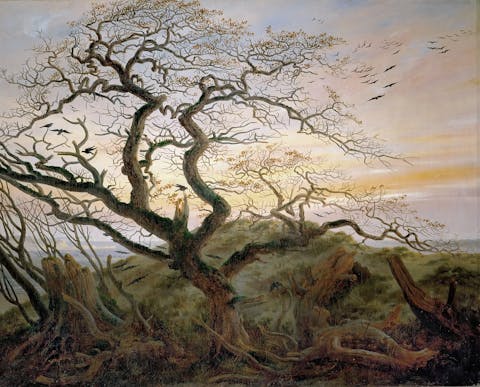
Caspar David Friedrich, The Tree of Crows, circa 1822. Image: Public Domain
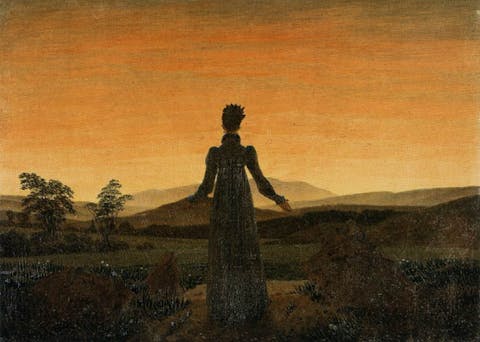
Caspar David Friedrich, Woman before the Rising Sun, 1818. Image: Public Domain
Egon Shiele’s Darkness
Arguably we are moving away from the true meaning of Halloween but in terms of the disturbing Egon Schiele’s [Austrian 1890-1918] 1911 painting Landscape with ravens takes us to a very dark place. It depicts a plot of land with cross-trees or crosses planted within along with an autumnal tree with a few leaves remaining all surrounded by a hill-top picket fence and topped by circling ravens. To find yourself in such a setting would be a good deal more frightening than opening the door to some badly costumed children.
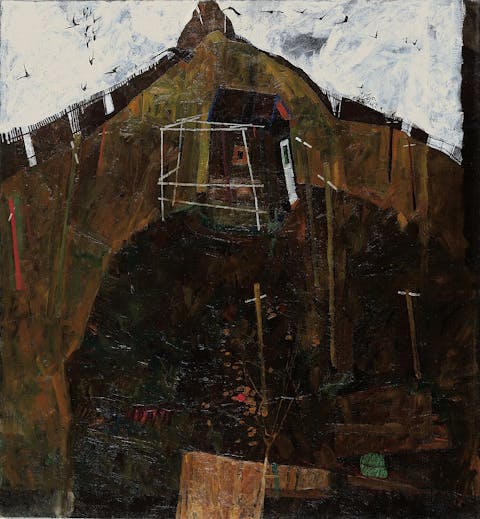
Egon Schiele, Landscape with Ravens, 1911. Image: Public Domain
Marie Spartali Stillman Depiction of Burial
Men do not have the monopoly of disturbing and the recently recognised by a stunning but justified result in auction the Pre-Raphaelite Marie Spartali Stillman’s [British 1844-1927] little known painting of Antigone giving Burial Rites to the body of her Brother Polynices has subject matter enough to be disturbing even beyond the usual interpretations of Greek Mythology. As she scatters the earth over the recumbent body whilst holding the hand of her sister[?] she is attended by the obligatory crows.
Abstract Halloween by Wilhelmina Barns-Graham
Another fine female artist’s painting worth noting here particularly because it is abstract in nature and different from the older style paintings discussed is Wilhelmina Barns-Graham’s [British 1912-2002] painting from the 1960’s in oil and acrylic on an aluminium panel with the Gracefield Art Centre Dumfries titled Assassination, Black, white and orange associated with Halloween because of the colouring particularly the orange and black. I doubt anyone will be frightened or disturbed by it, however it is certainly moving as is so much of her work which has yet to be appreciated fully.
Related: 13 fun facts about Halloween
Joyful Halloween Festivities at James Elder Christie
Having now depressed the readers that are still with us it is time to return to the theme of Halloween but on a more joyful note. James Elder Christie’s [British 1847-1914] Halloween Frolics in the Paisley Museum and Art Gallery depicts a happy procession of children carrying illuminated paper lanterns and pumpkins proceeding through the woods, strangely lead by some geese, but without any element of terror to be seen. Hopefully your visitors on the night will be equally charming and harmless but do stock up on some delights just in case that proves not to be the case!
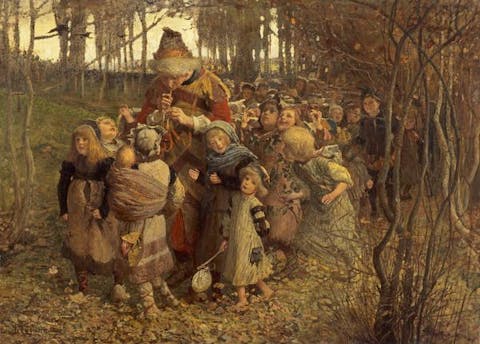
James Elder Christie, The Pied Piper of Hamelin, 1881, National Galleries of Scotland. Image: Pubic Domain
Submit your art and antiquities for appraisal here!
Nicholas Skeaping is the son of a famous British sculptor and painter John Skeaping RA. Our expert grew up in a house rife with art. He began his career in 1971 by converting an antiques shop into a Gallery to sell Victorian and Modern British paintings. Since then he has acquired forty years in the art world, travelling extensively throughout South Africa and South America in pursuit of ‘lost’ works.

